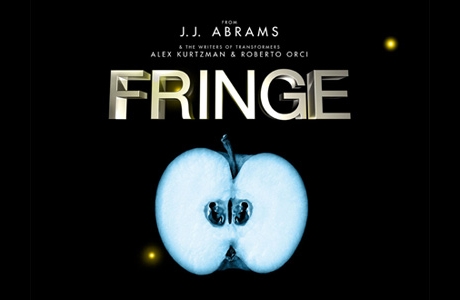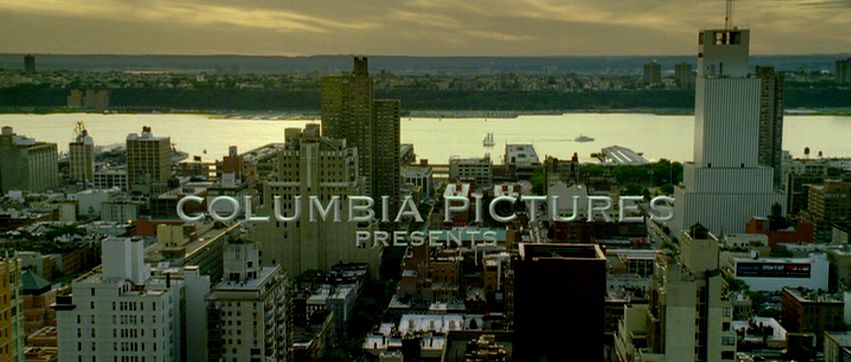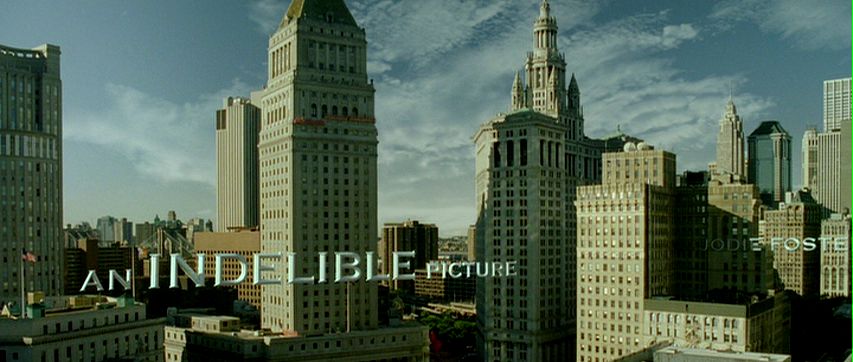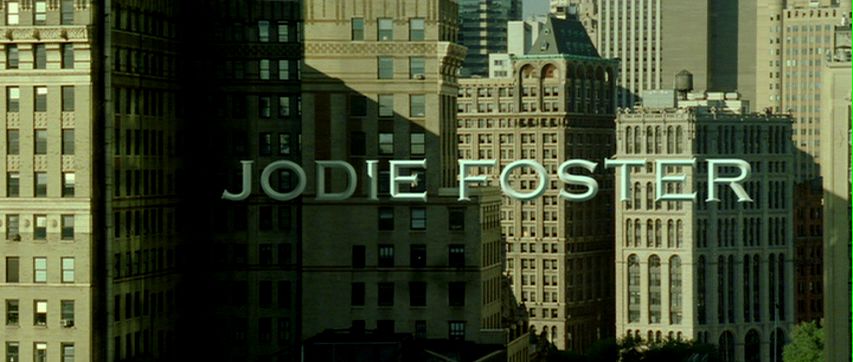
Once again I find myself without much to add to the positive consensus surrounding a new media release; in this case, it’s the FOX series Fringe, which had its premiere on Tuesday. My friends and fellow bloggers Jon Gray and Geoff Long both give the show props, which by itself would have convinced me to donate the time and DVR space to watch the fledgling serial spread its wings. The fact that the series is a sleek update of The X-Files is just icing on the cake.
In this case, it’s a cake whose monster-of-the-week decorations seem likely to rest on a creamy backdrop of conspiracy; let’s hope Fringe (if it takes off) does a better job of upkeep on its conspiracy than did X-Files. That landmark series — another spawn of the FOX network, though from long ago when it was a brassy little David throwing stones at the Goliaths of ABC, NBC, and CBS — became nearly axiomatic for me back in 1993 when I stumbled across it one Friday night. I watched it obsessively, first by myself, then with a circle of friends; it was, for a time, a perfect example not just of “appointment television” but of “subcultural TV,” accumulating local fanbaselets who would crowd the couch, eat take-out pizza, and stay up late discussing the series’ marvelously spooky adumbrations and witty gross-outs. But after about three seasons, the show began to falter, and I watched in sadness as The X-Files succumbed to the fate of so many serial properties that lose their way and become craven copies of themselves: National Lampoon, American Flagg, Star Wars.
The problem with X-Files was that it couldn’t, over its unforgivably extended run of nine seasons, sustain the weavework necessary for a good, gripping conspiracy: a counterpoint of deferral and revelation, unbelievable questions flowing naturally from believable answers with the formal intricacy of a tango. After about season six, I couldn’t even bring myself to watch anymore; to do so would have been like visiting an aged and senile relative in a nursing home, a loved one who could no longer recognize me, or me her.
I have no idea whether Fringe will ever be as good as the best or as bad as the worst of The X-Files, but I’m already looking forward to finding out. I’ve written previously about J. J. Abrams and his gift for creating haloes of speculation around the media properties with which his name is associated, such as Alias, Lost, and Cloverfield. He’s good at the open-ended promise, and while he’s proven himself a decent director of standalone films (I’m pretty sure the new Star Trek will rock), his natural environment is clearly the serial structure of dramatic television narrative, which even in its sunniest incarnation is like a friendly conspiracy to satisfy week-by-week while keeping us coming back for more.
As I stated at the beginning, other commentators are doing a fine job of assessing Fringe‘s premise and cast of characters. The only point I’ll add is that the show’s signature visual — as much a part of its texture as the timejumps on Lost or the fades-to-white on Six Feet Under — turns me on immensely. I’m speaking, of course, about the floating 3D titles that identify locale, as in this shot:
Jon points out that the conceit of embedding titles within three-dimensional space has been done previously in Grand Theft Auto 4. Though that videogame’s grim repetitiveness was too much (or not enough) for this gamer, I appreciated the title trick, and recognized it as having an even longer lineage. The truth is, embedded titles have been “floating” around the mediascape for several years. The first time I noticed them was in David Fincher’s magnificent, underrated Panic Room. There, the opening credits unfold in architectural space, suspended against the buildings of Manhattan in sunlit Copperplate:
My fascination with Panic Room, a high-tech homage to Alfred Hitchcock in which form mercilessly follows function (the whole film is a trap, a cinematic homology of the brownstone in which Jodie Foster defends herself against murderous intruders), began with that title sequence and only grew. Notice, for example, how Foster’s name lurks in the right-hand corner of one shot, as though waiting for its closeup in the next:
The work of visual-effects houses Picture Mill and Computer Cafe, Panic Room‘s embedded titles make us acutely uneasy by conflating two spaces of film spectatorship that ordinarily remain reassuringly separate: the “in-there” of the movie’s action and the “out-here” of credits, subtitles, musical score, and other elements that are of the movie but not perceivable by the characters in the storyworld. It’s precisely the difference between diegetic and nondiegetic, one of the basic distinctions I teach students in my introductory film course.
But embedded titles such as the ones in Panic Room and Fringe confound easy categorical compartmentalization, rupturing the hygienic membrane that keeps the double registers of filmic phenomenology apart. The titles hang in an undecidable place, with uncertain epistemological and ontological status, like ghosts. They are perfect for a show that concerns itself with the threads of unreality that run through the texture of the everyday.
Ironically, the titles on Fringe are receiving criticism from fans like those on this Ain’t It Cool talkback, who see them as a cliched attempt to capitalize on an overworked idea:
The pilot was okay, but the leads were dull and the dialogue not much better. And the establishing subtitles looked like double ripoff of the opening credits of Panic Room and the “chapter 1” titles on Heroes. They’re “cool”, but they’ll likely become distracting in the long run.
I hated the 3D text … This sort of things has to stop. it’s not cool, David Fincher’s title sequence in Panic Room was stupid, stop it. It completly takes me out of the scene when this stuff shows up on screen. It reminds you you’re watching TV. It takes a few seconds to realize it’s not a “real” object and other characters, cars, plans, are not seeing that object, even though it’s perfectly 3D shaded to fit in the scene. And it serves NO PURPOSE other than to take you out of the scene and distract you. it’s a dumb, childish, show-off-y amateurish “let’s copy Fincher” thing, and I want it out of this and Heroes.
…I DVR’d the show while I was working, came in about 40 minutes into it before flipping over to my recording. They were outside the building at Harvard and I thought, “Hey cool, Harvard built huge letters spelling out their name outside one of their buildings.”… then I realized they were just ripping off the Panic Room title sequence. Weak.
The visual trick of embedded titles is, like any fusion of style and technology, a packaged idea with its own itinerary and lifespan; it will travel from text to text and medium to medium, picked up here in a movie, there in a videogame, and again in a TV series. In an article I published last year in Film Criticism, I labeled such entities “microgenres,” basing the term on my observation of the strange cultural circulation of the bullet time visual effect:
If the sprawling experiment of the Matrix trilogy left us with any definite conclusion, it is this: special effects have taken on a life of their own. By saying this, I do not mean simply to reiterate the familiar (and debatable) claim that movies are increasingly driven by spectacle over story, or that, in this age of computer-generated imagery (CGI), special effects are “better than ever.” Instead, bullet time’s storied trajectory draws attention to the fact that certain privileged special effects behave in ways that confound traditional understandings of cinematic narrative, meaning, and genre — quite literally traveling from one place to another like mini-movies unto themselves. As The Matrix‘s most emblematic signifier and most quoted element, bullet time spread seemingly overnight to other movies, cloaking itself in the vestments of Shakespearean tragedy (Titus, 1999), high-concept television remake (Charlie’s Angels, 2000), caper film (Swordfish, 2001), teen adventure (Clockstoppers, 2002), and cop/buddy film (Bad Boys 2, 2003). Furthermore, its migration crossed formal boundaries into animation, TV ads, music videos, and computer games, suggesting that bullet time’s look — not its underlying technologies or associated authors and owners — played the determining role in its proliferation. Almost as suddenly as it sprang on the public scene, however, bullet time burned out. Advertisements for everything from Apple Jacks and Taco Bell to BMW and Citibank Visa made use of its signature coupling of slowed time and freely roaming cameras. The martial-arts parody Kung Pow: Enter the Fist (2002) recapped The Matrix‘s key moments during an extended duel between the Chosen One (Steve Oedekerk) and a computer-animated cow. Put to scullery work as a sportscasting aid in the CBS Superbowl, parodied in Scary Movie (2000), Shrek (2001), and The Simpsons, the once-special effect died from overexposure, becoming first a cliche, then a joke. The rise and fall of bullet time — less a singular special effect than a named and stylistically branded package of photographic and digital techniques — echoes the fleeting celebrity of the morph ten years earlier. Both played out their fifteen minutes of fame across a Best-Buy’s-worth of media screens. And both hint at the recent emergence of an unusual, scaled-down class of generic objects: aggregates of imagery and meaning that circulate with startling rapidity, and startlingly frank public acknowledgement, through our media networks.
Clearly, embedded titles are undergoing a similar process, arising first as an innovation, then reproducing virally across a host of texts. Soon enough, I’m sure, we’ll see the parodies: imagine a film of the Scary Movie ilk in which someone clonks his head on a floating title. Ah, well: such is media evolution. In the meantime, I’ll keep enjoying the effect in its more sober incarnation on Fringe, where this particular package of signifiers has found a respectful — and generically appropriate — home.







Alias (another J.J. Abrams franchise) always had the neat title motif of showing the name of the city and then zooming through the letters into the scene. I suppose this was probably a similar move but less upsetting to people because, instead of placing the titles within the diegesis, they stay outside but serve as a portal to pull us into the advertised locale. Still, I’m sure if a ton of shows started doing that people would probably get annoyed by it.
The idea of someone head-clonking against a title reminds me of the many jokes off of the on-screen advertisements they’ve have, including this one http://idents.tv/videos/watchtheshowtheirwatching.html
I haven’t seen Fringe yet but I’m eager to so I shall go download it now.
I wasn’t a big fan of the 3-D titles (and I’m still not), but I finally remembered what they reminded me of: the title designs for each issue of Will Eisner’s THE SPIRIT. I haven’t been able to find any samples of it from the old comics in a quick Google search, but there’s an homage to it in one of the posters for this fall’s film version from Frank Miller: http://www.jdmfilmreviews.com/images/the-spirit-frank-miler-poster1.jpg
I actually loved the titles, especially the moment in which we saw the underside of the Q in Iraq as the angle changed. The overhead shots — the titles, the maze-like shot of the chase scene near the beginning — seem to allude to seeing more of “The Pattern” in later episodes. In fact, it strikes me that there’s a perfect place for this title technique just waiting: comic book-style sound effects. Imagine fight scenes with the KRSSSHes and KATHUUUUMes actually appearing in the middle of the brawl, to be flung out of the way or used as cover. Somebody get Zack Snyder on the phone!
Geoff and Martyn: how interesting that both of you should invoke the graphic toolkit of the comic book to comment on Fringe‘s titles — it seems clear from this that we’re looking at a particularly explicit moment of convergence. In this case, convergence measured not in some grand alignment of storytelling systems or meta-organization of storyworlds but in the apparently trivial “travel” of a gimmick between two disparate (but increasingly incestuous) forms. Add to that Peter’s hilarious Simpsons video and we arrive at a place where all kinds of registers (from comic-book to live-action to animation) and genres (noir, SF, sitcom) are exchanging bodily fluids. The capillary transport of visual “germs” among complementary, compatible media bodies.
I suppose my biological metaphorizing and mention of the incest taboo reveal that I think there’s something deliciously scandalous about these migrations. Maybe that’s what drives the strong pro-or-con reactions to the Fringe titles: stern disapproval at “media miscegenation” from some, but for others a pornographic pleasure in watching different media get it on.
I’m happy to see the review — now I just have to watch it. The only sad part of the review was your merciless attack on X-Files. Ah, how I loved that show!
Hey, I loved it too! If I’m savage toward the show, it’s because it broke my heart — which can only happen in cases of true love.
While re-watching the premiere, on television this time, I saw an interesting little oddity. I’d just been in Toronto, so recognized the campus as University of Toronto, not, as is suggested (though may be true for that one external shot that you show?), Harvard. More interesting, though, was that the very cool new Royal Ontario Museum that stood in for Massive Dynamics in the preview that I saw at the Paley Center had now been turned into a faceless, boring skyscraper for television. I presume this is because Fringe isn’t filming in Toronto any longer, but it made for a way less cooler building
Fringe hasn’t come out in the UK yet, so I’ll reserve my judgement. I don’t mind the look of the titles, though. Nice touch. I remember as a kid being thrilled by the big chunky titles soaring over Manhattan/Metropolis at the start of the Superman movies. Not quite the same, but they were certainly moving with the camera. I wonder if there’s also a comparison to be made with the active intertitles of a film like F.W. Murnau’s Sunrise, which are animated to emphasise the sense of the words (though Murnau rarely used intertitles).
I’ll look out your Film Comment article as soon as I get chance. Just a shout out, though, for Dayton Taylor, who patented very similar multi-camera technology to that used in the Matrix, in 1994 and has rarely received credit for his input: http://www.timetrack.com/press/purpleprose.html
And another thing – if you wanted to taxonomise this particular phenomenon, you might also be interested in the increasingly stale tendency to adjust the studio logo to fit the theme of the film, also transgressing the boundary between diegesis and er, other stuff (I can’t remember what they call the bits that go before the title sequence):
http://www.ropeofsilicon.com/article/always_customizeable_studio_logo/
Dan, great connection to the titles on Donner’s 1978 Superman — one of the trio of films I cite for my students when they ask “What’s your favorite movie?” (The others are Star Wars — the one and only 1977 version — and Alien, 1979.) Funny, though; I don’t think of those zooming translucent titles as being “embedded” in the same sense as the Fringe or Panic Room graphics, despite their clear ties to rest of Superman‘s color palette and the crystalline motif that characterizes Krypton and the Fortress of Solitude. Not sure why that is. The swooshing titles appear again in Singer’s Superman Returns, but less effectively — pale, hurried CG remediations of Donner & co.’s work.
The microgenre piece can be found in Film Criticism 32:1 (2007). Yes, my genealogy of bullet time does discuss Dalton Taylor, as well as Tim McMillan — just some of the effect’s multiple authors. My friend Mark Wolf has a great piece on Taylor, time-slice, and bullet time: “Space, Time, Frame, Cinema: Exploring the Possibilities of Spatiotemporal Effects,” in New Review of Film and Television Studies 4:3 (2006).
Interesting idea about the graphic contagion of studio logos (I noticed it in The Matrix, which “greenifies” the Warner Brothers tag, but my favorite instance is probably the “global warming” effect applied to the Universal globe in Waterworld). Not sure I would call this a diegetic spread so much as a mutation of branding … but it’s worth investigating!
Bob, I’m going to try to use the phrase “diegetic spread” every day from now on.
It’s a while since I’ve seen Panic Room, so I can’t quite remember if there was any particular significance to the embedded titles, except to flag up the importance of walls and corners and hiding places inside urban space. And the titles lurk unnoticed, even though they’re HUGE. Actually, that’s significant enough, I reckon. The opening titles on Seven are often cited as a landmark, but the scratchy electroshock aesthetic doesn’t really encapsulate the meticulous, self-assured calm of the serial killer it depicts. In fact, those titles make it easier to write him off as a fractured, deranged mind rather than the “alternatively reasonable” guy the film wants you to be frightened by.
I had imagined there were lots of manipulations of studio logos, but I can’t really think of any now that I need to. I seem to recall the Columbia Pictures logo lady doing something undignified, but I may have dreamed that one up…
On closer examination, “diegetic spread” does sound like something one would use on toast instead of butter … “diegetic sprawl” and “diegetic leakage” are no improvement, but perhaps come nearer to what I was intending.
Excellent reading of Panic Room‘s (and Seven‘s) title logic. Fincher has said he wanted the opening of Panic Room to convey expansive scale in contrast to the airtight “interior” of the film. To me, the movie enacts a remarkable calculus of claustrophobia and freedom, mingling transparency and opacity through visual devices like the embedded titles and “x-ray” traveling shots (which themselves came in for criticism from some quarters), the mise-en-scene of the sealed, impervious panic room (a “black box” counterintuitively perforated by video surveillance), even the extratextual factor of Jodie Foster’s disavowed (or unavowed) queer identity — itself a kind of black-boxed star image.
I’ve listed the few instances of logo play that come to my mind, but will ponder further the question of Columbia’s logo lady. (Didn’t she get revamped and modernized a few years ago a la Betty Crocker?) I think 20th Century Fox’s logo did something unusual before the X-Men films, fading out but leaving a subtle little glow around the “x.” And it seems to me there’s been some musical manipulation of the famous 20th-C Fox intro; in ’77 they appended the Cinemascope extension, written by Alfred Newman in 1954, to the opening of Star Wars, and Alien Resurrection (if I remember correctly) has the same musical notes dropping into a minor, “horrific” key as a segue into the film.
My mentor Paul Grainge (University of Nottingham) wrote an article and book which contains elements of an argument on studio logos and what I will call their “metamorphing.” His book is called “Brand Hollywood,” and I believe that his article was earlier published in an issue of Screen.
By the way, if I may be so bold (sorry, Dan), none of the Superman films’ opening credits were ever placed over the Metropolis/Manhattan skyline, although Superman III’s huge, intrusive credits flowed directly “out of” downtown Metropolis as Superman saves a city in chaos. All the rest of the Superman franchise contemporary live-action feature films featured the titles in space, and/or over Earth or in some nebulous region (Supergirl). Interesting that you remember it that way, however…it says something for the imagery of the film(s).
Thanks, Mike. Yes, it is interesting when a very vivid memory turns out to be false (or maybe I just remembered the Superman III titles most!), the problem being that you can always check with a movie, so I can’t blag it! For another example, I once had an argument with a friend over the type of sweets/candy Elliot leaves a trail of for E.T. to follow. My friend thought it was Reese’s Pieces, and I swore blind it was M&Ms. I specifically remember E.T. being used as a launchpad for M&Ms in the UK, since they’d previously been unavailable. I’ve seen the film again and obviously I was wrong, but I still suspect that there may have been a “special edition” sponsored by M&Ms and recut accordingly to place their product and released in the UK! But a more likely theory is that the novelisation featured M&Ms instead. Even more likely is that I was seven years old at the time and my brain got a bit fuzzed in subsequent decades.
By the way, Mike’s mention of Paul Grainge’s terrific article referred me to this interesting post on studio logos at Aspect Ratio. It chimes with what Bob and I were saying about manipulated logos:
http://aspectratio.wordpress.com/2008/09/05/studio-logos-by-association/
Yes, Dan, I had caught the Variety article that the above article you linked to, has itself linked to, and was going to post that here…I had just forgotten. Thanks.
So we know who does the embedded title treatment but does anyone know how or with what software it was done with? are the clips split with the graphic then layered in?
Thanks
another similar treatment that I really like is on I Robot when Will Smith is talking to the active video of the dead Dr. on the entry floor. I can figure out the embedded video but adding the camera move was the icing on the cake. Anyone have an idea on this one also. I expect they were done similarly to the floating embedded titles.